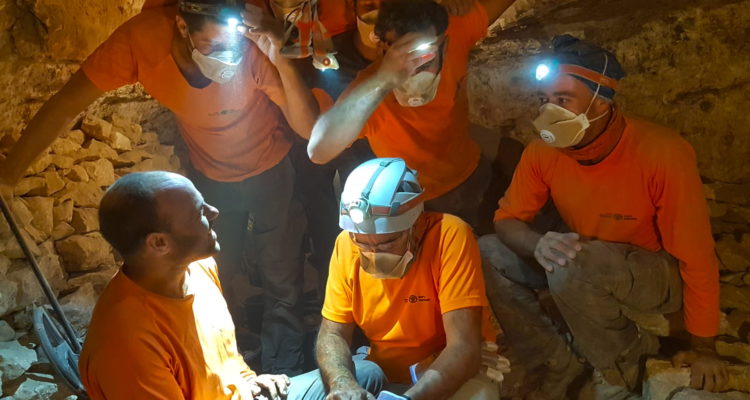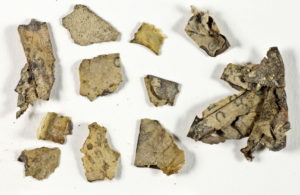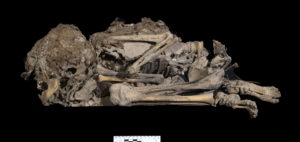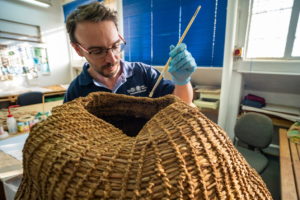Also discovered were rare coins, a 6,000 year-old mummified skeleton of a child and a large complete basket, likely the oldest in the world.
By World Israel News Staff
For the first time in approximately 60 years, archaeological excavations have uncovered fragments of a biblical scroll. The scroll, which is written in Greek, includes portions of the Book of the Twelve Minor Prophets, including the books of Zechariah and Nahum
The verses, from Zechariah 8:16–17 were discovered in a cave where Jewish refugees hid almost 1900 years ago. They read:
“These are the things you are to do: Speak the truth to one another, render true and perfect justice in your gates. And do not contrive evil against one another, and do not love perjury, because all those are things that I hate—declares the Lord.”
Also identified, on another fragment, are verses from Nahum 1:5–6:
“The mountains quake because of Him, And the hills melt. The earth heaves before Him, The world and all that dwell therein. Who can stand before His wrath? Who can resist His fury? His anger pours out like fire, and rocks are shattered because of Him.”
The verses, written on dozens of parchment fragments were discovered in a complex and challenging national-archaeological operation undertaken by the Israel Antiquities Authority on the cliffs of the Judean Desert, since 2017, in order to prevent antiquities looting.
The historic discovery comes 60 years after the last discovery of biblical scrolls in archaeological excavations.
In addition to the scroll fragments, the operation uncovered additional extraordinary finds from various periods: a cache of rare coins from the days of Bar-Kokhba, a 6,000 year-old skeleton of a child – likely female, wrapped in a cloth and mummified, and a large complete basket dating back 10,500 years, likely the oldest in the world.
The cave where they were found, roughly 80 meters below the cliff top, is flanked by gorges and can only be reached by rappelling precariously down the sheer cliff.
Additional finds left behind by the Jewish rebels who fled to the caves at the end of the Bar Kokhba Revolt include arrow- and spear-heads, woven fabric, sandals and even lice combs.
Ever since the Dead Sea Scrolls were discovered over 70 years ago, the desert caves have been targeted by antiquities looters. The climatic conditions inside the caves have enabled the exceptional preservation of scrolls and ancient documents, which are cultural heritage assets of immense importance. As such, they are sought after by cave looters, who risk life and limb in their search, as well as damaging the caves and destroying historical evidence.
“The aim of this national initiative is to rescue these rare and important heritage assets from the robbers’ clutches,” says Israel Antiquities Authority’s director Israel Hasson, who launched the national operation.
“The newly discovered scroll fragments are a wakeup call to the state. Resources must be allocated for the completion of this historically important operation. We must ensure that we recover all the data that has not yet been discovered in the caves, before the robbers do. Some things are beyond value,” Hasson adds.
Another astounding discovery was that of the 6,000-year-old partially mummified skeleton of a child, found in what has been dubbed the Cave of Horror. The child, 6-12 years old, is wrapped in cloth. Skin, tendons and even hair were partially preserved.
According to prehistorian Ronit Lupu of the Israel Antiquities Authority, “On moving two flat stones, we discovered a shallow pit intentionally dug beneath them, containing a skeleton of a child placed in a fetal position. It was covered with a cloth around its head and chest, like a small blanket, with its feet protruding from it. It was obvious that whoever buried the child had wrapped him up and pushed the edges of the cloth beneath him, just as a parent covers his child in a blanket.”
Also discovered was a huge intact basket with a lid that was also exceptionally well preserved due to the high temperatures and extreme aridity of the region. The basket dates to the Pre-Pottery Neolithic period.
Israeli archaeologists say it’s the oldest basket in the world that has been found completely intact and its importance is therefore immense. The basket had a capacity of 90–100 liters and was apparently used for storage. The basket provides fascinating new data on the storage of products some 1,000 years before the invention of pottery.
The basket is woven from plant material and its method of weaving is unusual. When it was found it was empty, and only future research of a small amount of soil remaining inside it will help us discover what it was used for and what was placed in it.








